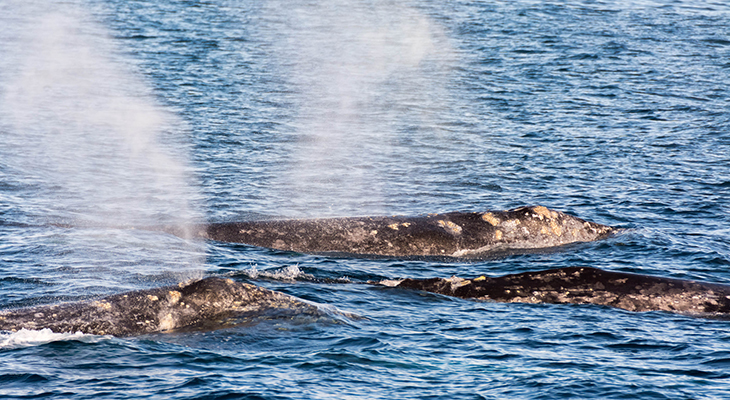Diagnosing Whales By Drone

(Inside Science) -- A bicoastal team of marine biologists has developed and tested a new noninvasive method of diagnosing the health of endangered whales that relies on a small, unmanned drone.
The drone, called a hexacopter because it has six whirling rotors, collects data from two different altitudes.
An onboard camera first takes high-resolution photographs of the entire body of a target whale while hovering between 125 and 150 feet above the ocean's surface. The photographs permit scientists to make precise measurements of the whale's body dimensions, a process called photogrammetry.
The hexacopter then swoops down to an altitude of about ten feet to capture samples of the mammal's breath spurting from its blow hole. Those samples can then be assayed -- that is, examined in the laboratory -- to identify their contents.
"This is the first time to combine photogrammetry measures of body conditions with assays of respiratory health," said Michael Moore, director of the Woods Hole Oceanographic Institution's Marine Mammal Center in Massachusetts and leader of the project. "The combination is a unique way of noninvasively testing the health a whale," he added.
"This approach gives us new insight into whales' body conditions, and allows us to study large numbers of animals," said Frances Gulland, senior scientist at The Marine Mammal Center in Sausalito, California, who was not involved in the project.
The photos allow researchers to spot skin lesions and measure the length and width of a whale to within a few inches. The ratio of length to width is a good indicator of its health, according to Moore. The photos can also provide some indication of individual whales' family history.
"The width and length of the animal give you its overall health status, but don't explain why," Moore said. "For more, you need condensed breath or poop." Breath, he explained, can be examined faster.
The breath samples contain droplets of oil and gases that can yield information about the health of a whale's respiratory tract. WHOI geochemist Amy Apprill analyzes DNA in the droplets to measure the types and levels of microorganisms in the lungs, the most common sources of disease in whales. The analysis can also cast light on other issues such as whales' stress levels.
Apprill has just started to study breath samples gathered in July from humpback whales in the Stellwagen Bank National Marine Sanctuary off New England.
The plan, Apprill said, is "to detect pathogens associated with the microbes found in the breath."
Her research team has already found genes from microorganisms in the samples. "The next step is to identify them," she added.
Gulland expects further advances from the research.
"Breath can give insights into metabolism. And we can potentially use it to look into hormones, which are important to whales' health," she said.
During the past 15 years, Moore's colleague Wayne Perryman has flown on fixed-wing planes and helicopters to photograph whales from directly above. Other teams have traveled in boats to capture whales' breath, using a pole and a net mesh.
"You sneak up on the whale and dangle the pole over its blowhole," Moore explained.
Moore and Perryman first used a hexacopter to photograph sperm whales off New Zealand in 2013. The following year, Perryman worked with John Durban, a biologist and also a collaborator on the new research, to improve the method of controlling the onboard camera remotely. They used it to photograph killer whales off the coast of British Columbia.
In neither case, however, did the scientists use the drone to capture whales' breath.
One reason for that was concern that their sophisticated hexacopter might be damaged if it tried to descend close to the whale to collect breath as well. In response, the team planned to add a second drone -- a cheap off-the-shelf model -- for that task.
But "playing with two toys at once," as Moore put it, proved too complicated. So the team added the capacity for sampling whales' breath to their original hexacopter and tested the approach on the Stellwagen humpbacks in July.
Having shown how to use the method, the team now plans to apply it to humpback whales in the ocean off the Antarctic Peninsula, whose waters are much cleaner. The Stellwagen, on the other hand, has significant ship traffic, fishing, and pollution.
Comparison of the two sets of samples, Moore said, "will give us a new understanding of the relationship between whale body condition and health in the context of habitat quality."
More broadly, the technology has application beyond humpbacks. It provides a promising means of remotely observing the health and behavior of whales of all species wherever they live.

